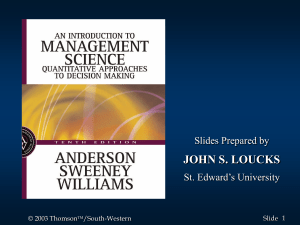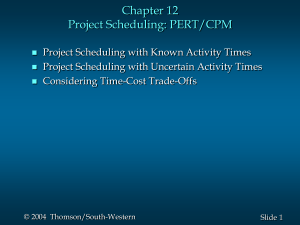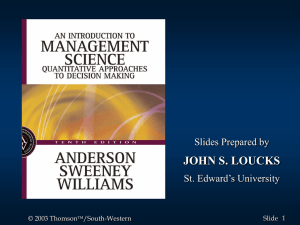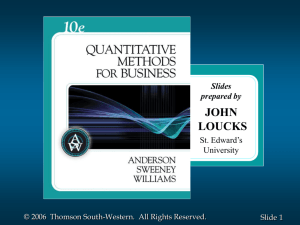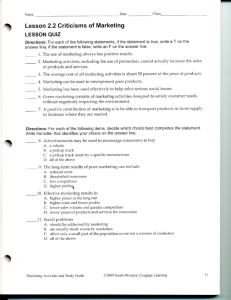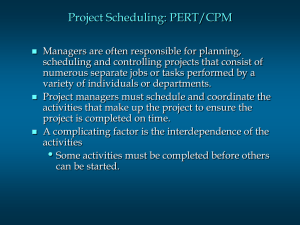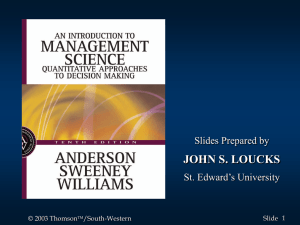Project Scheduling: PERT/CPM
advertisement
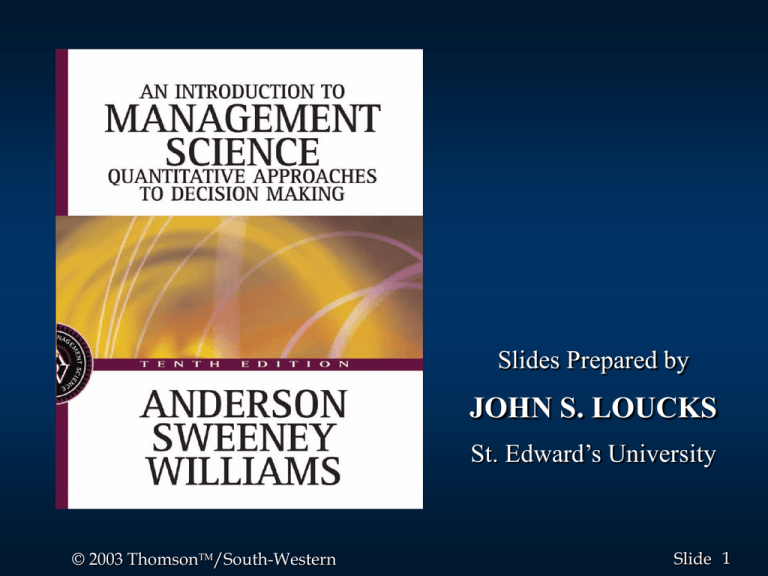
Slides Prepared by JOHN S. LOUCKS St. Edward’s University © 2003 ThomsonTM/South-Western Slide 1 Chapter 10 Project Scheduling: PERT/CPM Project Scheduling with Known Activity Times Project Scheduling with Uncertain Activity Times Considering Time-Cost Trade-Offs © 2003 ThomsonTM/South-Western Slide 2 PERT/CPM PERT • Program Evaluation and Review Technique •Developed by U.S. Navy for Polaris missile project •Developed to handle uncertain activity times CPM •Critical Path Method •Developed by Du Pont & Remington Rand •Developed for industrial projects for which activity times generally were known Today’s project management software packages have combined the best features of both approaches. © 2003 ThomsonTM/South-Western Slide 3 PERT/CPM PERT and CPM have been used to plan, schedule, and control a wide variety of projects: •R&D of new products and processes •Construction of buildings and highways •Maintenance of large and complex equipment •Design and installation of new systems © 2003 ThomsonTM/South-Western Slide 4 PERT/CPM PERT/CPM is used to plan the scheduling of individual activities that make up a project. Projects may have as many as several thousand activities. A complicating factor in carrying out the activities is that some activities depend on the completion of other activities before they can be started. © 2003 ThomsonTM/South-Western Slide 5 PERT/CPM Project managers rely on PERT/CPM to help them answer questions such as: •What is the total time to complete the project? •What are the scheduled start and finish dates for each specific activity? •Which activities are critical and must be completed exactly as scheduled to keep the project on schedule? •How long can noncritical activities be delayed before they cause an increase in the project completion time? © 2003 ThomsonTM/South-Western Slide 6 Project Network A project network can be constructed to model the precedence of the activities. The nodes of the network represent the activities. The arcs of the network reflect the precedence relationships of the activities. A critical path for the network is a path consisting of activities with zero slack. © 2003 ThomsonTM/South-Western Slide 7 Example: Frank’s Fine Floats Frank’s Fine Floats is in the business of building elaborate parade floats. Frank and his crew have a new float to build and want to use PERT/CPM to help them manage the project . The table on the next slide shows the activities that comprise the project. Each activity’s estimated completion time (in days) and immediate predecessors are listed as well. Frank wants to know the total time to complete the project, which activities are critical, and the earliest and latest start and finish dates for each activity. © 2003 ThomsonTM/South-Western Slide 8 Example: Frank’s Fine Floats Immediate Activity Description Predecessors A Initial Paperwork --B Build Body A C Build Frame A D Finish Body B E Finish Frame C F Final Paperwork B,C G Mount Body to Frame D,E H Install Skirt on Frame C © 2003 ThomsonTM/South-Western Completion Time (days) 3 3 2 3 7 3 6 2 Slide 9 Example: Frank’s Fine Floats Project Network Start B D 3 3 G F 6 A 3 3 E C 2 © 2003 ThomsonTM/South-Western 7 Finish H 2 Slide 10 Earliest Start and Finish Times Step 1: Make a forward pass through the network as follows: For each activity i beginning at the Start node, compute: •Earliest Start Time = the maximum of the earliest finish times of all activities immediately preceding activity i. (This is 0 for an activity with no predecessors.) •Earliest Finish Time = (Earliest Start Time) + (Time to complete activity i ). The project completion time is the maximum of the Earliest Finish Times at the Finish node. © 2003 ThomsonTM/South-Western Slide 11 Example: Frank’s Fine Floats Earliest Start and Finish Times B 3 6 D 3 3 F Start A 6 9 G 6 9 12 18 6 3 0 3 3 E C 3 5 2 © 2003 ThomsonTM/South-Western 7 Finish 5 12 H 5 7 2 Slide 12 Latest Start and Finish Times Step 2: Make a backwards pass through the network as follows: Move sequentially backwards from the Finish node to the Start node. At a given node, j, consider all activities ending at node j. For each of these activities, i, compute: •Latest Finish Time = the minimum of the latest start times beginning at node j. (For node N, this is the project completion time.) •Latest Start Time = (Latest Finish Time) - (Time to complete activity i ). © 2003 ThomsonTM/South-Western Slide 13 Example: Frank’s Fine Floats Latest Start and Finish Times Start 6 9 B 3 6 D 3 6 9 3 9 12 F 6 9 A 0 3 3 15 18 3 0 3 E 5 12 7 5 12 C 3 5 2 3 5 © 2003 ThomsonTM/South-Western G 12 18 6 12 18 Finish H 5 7 2 16 18 Slide 14 Determining the Critical Path Step 3: Calculate the slack time for each activity by: Slack = (Latest Start) - (Earliest Start), or = (Latest Finish) - (Earliest Finish). © 2003 ThomsonTM/South-Western Slide 15 Example: Frank’s Fine Floats Activity Slack Time Activity ES EF A 0 3 B 3 6 C 3 5 D 6 9 E 5 12 F 6 9 G 12 18 H 5 7 © 2003 ThomsonTM/South-Western LS 0 6 3 9 5 15 12 16 LF Slack 3 0 (crit.) 9 3 5 0 (crit.) 12 3 12 0 (crit.) 18 9 18 0 (crit.) 18 11 Slide 16 Example: Frank’s Fine Floats Determining the Critical Path •A critical path is a path of activities, from the Start node to the Finish node, with 0 slack times. •Critical Path: A–C–E–G •The project completion time equals the maximum of the activities’ earliest finish times. •Project Completion Time: © 2003 ThomsonTM/South-Western 18 days Slide 17 Example: Frank’s Fine Floats Critical Path Start 6 9 B 3 6 D 3 6 9 3 9 12 F 6 9 A 0 3 3 15 18 3 0 3 E 5 12 7 5 12 C 3 5 2 3 5 © 2003 ThomsonTM/South-Western G 12 18 6 12 18 Finish H 5 7 2 16 18 Slide 18 Uncertain Activity Times In the three-time estimate approach, the time to complete an activity is assumed to follow a Beta distribution. An activity’s mean completion time is: t = (a + 4m + b)/6 An activity’s completion time variance is: 2 = ((b-a)/6)2 •a = the optimistic completion time estimate •b = the pessimistic completion time estimate •m = the most likely completion time estimate © 2003 ThomsonTM/South-Western Slide 19 Uncertain Activity Times In the three-time estimate approach, the critical path is determined as if the mean times for the activities were fixed times. The overall project completion time is assumed to have a normal distribution with mean equal to the sum of the means along the critical path and variance equal to the sum of the variances along the critical path. © 2003 ThomsonTM/South-Western Slide 20 Example: ABC Associates Consider the following project: Immed. Optimistic Most Likely Pessimistic Activity Predec. Time (Hr.) Time (Hr.) Time (Hr.) A -4 6 8 B -1 4.5 5 C A 3 3 3 D A 4 5 6 E A 0.5 1 1.5 F B,C 3 4 5 G B,C 1 1.5 5 H E,F 5 6 7 I E,F 2 5 8 J D,H 2.5 2.75 4.5 K G,I 3 5 7 © 2003 ThomsonTM/South-Western Slide 21 Example: ABC Associates Project Network D J 5 3 H A E 6 1 6 I Start C F 3 4 5 Finish K B G 4 2 © 2003 ThomsonTM/South-Western 5 Slide 22 Example: ABC Associates Activity Expected Times and Variances Activity A B C D E F G H I J K t = (a + 4m + b)/6 2 = ((b-a)/6)2 Expected Time Variance 6 4/9 4 4/9 3 0 5 1/9 1 1/36 4 1/9 2 4/9 6 1/9 5 1 3 1/9 5 4/9 © 2003 ThomsonTM/South-Western Slide 23 Example: ABC Associates Earliest/Latest Times and Slack Activity A B C D E F G H I J K ES 0 0 6 6 6 9 9 13 13 19 18 © 2003 ThomsonTM/South-Western EF LS LF Slack 6 0 6 0* 4 5 9 5 9 6 9 0* 11 15 20 9 7 12 13 6 13 9 13 0* 11 16 18 7 19 14 20 1 18 13 18 0* 22 20 23 1 23 18 23 0* Slide 24 Example: ABC Associates Determining the Critical Path •A critical path is a path of activities, from the Start node to the Finish node, with 0 slack times. •Critical Path: A–C– F– I– K •The project completion time equals the maximum of the activities’ earliest finish times. •Project Completion Time: © 2003 ThomsonTM/South-Western 23 hours Slide 25 Example: ABC Associates Critical Path (A-C-F-I-K) 6 11 5 15 20 D 19 22 3 20 23 J 13 19 6 14 20 H 0 6 6 0 6 A 6 7 1 12 13 E 13 18 5 13 18 I Start 6 9 3 6 9 C 9 13 4 9 13 F Finish 18 23 5 18 23 K 0 4 4 5 9 B © 2003 ThomsonTM/South-Western 9 11 2 16 18 G Slide 26 Example: ABC Associates Probability the project will be completed within 24 hrs 2 = 2A + 2C + 2F + 2H + 2K = 4/9 + 0 + 1/9 + 1 + 4/9 =2 = 1.414 z = (24 - 23)/(24-23)/1.414 = .71 From the Standard Normal Distribution table: P(z < .71) = .5 + .2612 = © 2003 ThomsonTM/South-Western .7612 Slide 27 PERT/Cost PERT/Cost is a technique for monitoring costs during a project. Work packages (groups of related activities) with estimated budgets and completion times are evaluated. A cost status report may be calculated by determining the cost overrun or underrun for each work package. Cost overrun or underrun is calculated by subtracting the budgeted cost from the actual cost of the work package. For work in progress, overrun or underrun may be determined by subtracting the prorated budget cost from the actual cost to date. © 2003 ThomsonTM/South-Western Slide 28 PERT/Cost The overall project cost overrun or underrun at a particular time during a project is determined by summing the individual cost overruns and underruns to date of the work packages. © 2003 ThomsonTM/South-Western Slide 29 Example: How Are We Doing? Consider the following project network: A 9 Start B 8 G 3 I 4 F 4 H 5 Finish D 3 J E 4 8 C 10 © 2003 ThomsonTM/South-Western Slide 30 Example: How Are We Doing? Earliest/Latest Times Activity A B C D E F G H I J ES 0 0 0 8 8 9 9 12 12 17 © 2003 ThomsonTM/South-Western EF LS LF Slack 9 0 9 0* 8 5 13 5 10 7 17 7 11 22 25 14 12 13 17 5 13 13 17 4 12 9 12 0* 17 12 17 0* 16 21 25 9 25 17 25 0* Slide 31 Example: How Are We Doing? Activity Status (End of Week 11) Activity A B C D E F G H I J Actual Cost $6,200 5,700 5,600 0 1,000 5,000 2,000 0 0 0 © 2003 ThomsonTM/South-Western % Complete 100 100 90 0 25 75 50 0 0 0 Slide 32 Example: How Are We Doing? Cost Status Report (Assuming a budgeted cost of $6000 for each activity) Activity Actual Cost A $6,200 B 5,700 C 5,600 D 0 E 1,000 F 5,000 G 2,000 H 0 I 0 J 0 Totals $25,500 © 2003 ThomsonTM/South-Western Value Difference (1.00)x6000 = 6000 $200 (1.00)x6000 = 6000 - 300 (.90)x6000 = 5400 200 0 0 (.25)x6000 = 1500 - 500 (.75)x6000 = 4500 500 (.50)x6000 = 3000 -1000 0 0 0 0 0 0 $26,400 $- 900 Slide 33 Example: How Are We Doing? PERT Diagram at End of Week 11 G Start A 11 0 11 B 11 0 11 11 1.5 12.5 I 12.5 4 16.5 F 11 H 12.5 1 12 5 17.5 D 11 3 14 E 11 3 14 C 11 1 12 © 2003 ThomsonTM/South-Western Finish J 17.5 8 25.5 Earliest Start Earliest Finish Remaining work (weeks) Slide 34 Example: How Are We Doing? Corrective Action Note that the project is currently experiencing a $900 cost underrun, but the overall completion time is now 25.5 weeks or a .5 week delay. Management should consider using some of the $900 cost savings and apply it to activity G to assist in a more rapid completion of this activity (and hence the entire project). © 2003 ThomsonTM/South-Western Slide 35 Critical Path Method In the Critical Path Method (CPM) approach to project scheduling, it is assumed that the normal time to complete an activity, tj , which can be met at a normal cost, cj , can be crashed to a reduced time, tj’, under maximum crashing for an increased cost, cj’. Using CPM, activity j's maximum time reduction, Mj , may be calculated by: Mj = tj - tj'. It is assumed that its cost per unit reduction, Kj , is linear and can be calculated by: Kj = (cj' - cj)/Mj. © 2003 ThomsonTM/South-Western Slide 36 End of Chapter 10 © 2003 ThomsonTM/South-Western Slide 37
